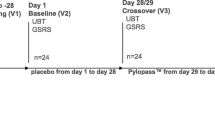Abstract
H. pylori infection is associated with acid-peptic disease, although its role in the pathogenesis is unclear. The purpose of this study was to determine if chronic infection in asymptomatic subject impairs the inhibition of meal-stimulated gastrin and acid secretion that is observed normally at low intragastric pH. Presence of infection was determined by both C-14 urea breath test and serology. Acid secretion was measured under basal conditions and in response to peptone meal stimulation and pentagastrin. Plasma gastrin concentrations were determined by radioimmunoassay under basal conditions and during peptone meal stimulation. Intragastric titration with 1% peptone during the first hour, and 8% peptone during the second hour, was performed at both pH 7.0 and 2.5 on different days to compare the inhibition of gastrin and acid secretion. Compared to noninfected subjects, asymptomatic individuals infected withH. pylori had significantly increased: (1) basal gastrin values (P<0.005); (2) 8% peptone-stimulated gastrin responses at both pH 7.0 and 2.5 (P<0.05); and (3) 8% peptone-stimulated acid output at pH 2.5 (P=0.01). During the second hour of peptone-stimulation, subjects infected withH. pylori had significantly decreased inhibition of gastrin (52% vs 95%) (P=0.002) and acid (30% vs 81%) (P=0.01) secretion from pH 7.0 to 2.5. Thus, chronic infection withH. pylori results in impaired inhibition of gastrin and acid secretion at low intragastric pH during the second hour of peptone meal stimulation. These defects may be unrelated to the pathogenesis of acid-peptic disease, since they occur in asymptomatic subjects infected withH. pylori.
Similar content being viewed by others
References
Walsh JH, Richardson CT, Fordtran JS: pH dependence of acid secretion and gastrin release in normal and ulcer subjects. J Clin Invest 55:462–468, 1975
Malagelada JR, Longstreth GF, Deering TB, Summerskill WHJ, Go VLW: Gastric secretion and emptying after ordinary meals in duodenal ulcer. Gastroenterology 73:989–994, 1977
Lam SK, Isenberg JI, Grossman MI, Lane WH, Walsh JH: Gastric acid secretion is abnormally sensitive to endogenous gastrin released after peptone test meals in duodenal ulcer patients. J Clin Invest 65:555–562, 1980
Fordtran JS, Walsh JH: Gastric acid secretion rate and buffer content of stomach after eating. J Clin Invest 52:645–657, 1973
Thompson JC, Swierczek JS: Acid and endocrine responses to meals varying in pH in normal and duodenal ulcer subjects. Ann Surg 186:541–547, 1977
Blair AJ, Feldman M, Barnett C, Walsh JH, Richardson CT: Detailed comparison of basal and food-stimulated gastric acid secretion rates and serum gastrin concentrations in duodenal ulcer patients and normal subjects. J Clin Invest 79:582–587, 1987
Chamberlain CE, Peura DA:Campylobacter (Helicobacter) pylori—Is peptic disease a bacterial infection? Arch Intern Med 150:951–955, 1990
Ormand JE, Talley NJ:Helicobacter pylori: Controversies and an approach to management. Mayo Clin Proc 65:414–426, 1990
Levi S, Haddad G, Ghosh P, Beardshall K, Playford R, Calam J:Campylobacter pylori and duodenal ulcers: The gastrin link. Lancet 1:1167–1168, 1989
Levi S, Beardshall K, Desa LA, Calam J:Campylobacter pylori, gastrin, acid secretion, and duodenal ulcers. Lancet 2:613, 1989
McColl KEL, Fullarton GM, El Nujumi AM, MacDonald AM: Lowered gastrin and gastric acidity after eradication ofCampylobacter pylori in duodenal ulcer. Lancet 2:499–500, 1989
Graham DY, Opekun A, Lew GM, Evans DJ, Klein PD, Evans DG, Brown IL, Hilditch TE: Ablation of exaggerated meal-stimulated gastrin release in duodenal ulcer patients after clearance ofHelicobacter (Campylobacter) pylori infection. Am J Gastroenterol 85:394–398, 1990
Karnes WE, Ohning GV, Sytnik B, Kim SWR, Walsh JH: Elevation of meal-stimulated gastrin release in subjects withHelicobacter pylori infection: Reversal by low intragastric pH. Rev Infect Dis 13:S665-S670, 1991
Marshall BJ, Surveyor I: Carbon-14 urea breath test for the diagnosis ofCampylobacter pylori associated gastritis. J Nucl Med 29:11–16, 1988
Walsh JH: Radioimmunoassay of gastrin.In Nuclear Medicinein Vitro. B Roth (ed). Philadelphia, JB Lippincott, 1974, pp 231–248
Kovacs TOG, Walsh JH: Standard secretory tests: Methodology.In Clinical Investigation of Gastric Function, Vol 17, Chapter 1. C Scarpignato, G Bianchiporro (eds). Basel, Switzerland, Karger, 1990, pp 2–12
Maxwell V, Eysselein VE, Kleibeuker J, Reedy T, Walsh JH: Glucose perfusion intragastric titration. Dig Dis Sci 29:321–326, 1984
Graham DY, Opekun A, Lew GM, Klein PD, Walsh JH:Helicobacter pylori associated exaggerated gastrin release in duodenal ulcer patients. Gastroenterology 100:1571–1575, 1991
Chittajallu RS, Neithercut WD, Macdonald AMI, McColl KEL: Effect of increasingHelicobacter pylori ammonia production by urea infusion on plasma gastrin concentrations. Gut 32:21–24, 1991
Blaser MJ: Hypotheses on the pathogenesis and natural history ofHelicobacter pylori-induced inflammation. Gastroenterology 102:720–727, 1992
Smith JTL, Pounder RE, Nwokolo CU, Lanzon-Miller S, Evans DG, Graham DY, Evans DJ: Inappropriate hypergastrinemia in asymptomatic healthy subjects infected withHelicobacter pylori. Gut 31:522–525, 1990
Prewett EJ, Smith JTL, Nwokolo CU, Hudson M, Sawyerr AM, Pounder RE: Eradication of Helicobacter pylori abolishes 24-hour hypergastrinaemia: A prospective study in healthy subjects. Aliment Pharmacol Ther 5:283–290, 1991
Goldschmiedt M, Barnett CC, Schwarz BE, Karnes WE, Redfern JS, Feldman M: Effect of age on gastric acid secretion and serum gastrin concentrations in healthy men and women. Gastroenterology 101:1–9, 1991
Alpert LC, Lew GM, Michaletz PA, Graham DY: Effect of eradication ofC. pylori on gastric function and structure. Gastroenterology 96:10, 1989 (abstract)
Cave DR, Vargas M: Effect of a Campylobacter pylori protein on acid secretion by parietal cells. Lancet 2:187–189, 1989
Author information
Authors and Affiliations
Additional information
Work supported in part by Veterans Affairs Medical Research Funds. Dr. Tarnasky was recipient of a 1990 Research Fellowship stipend sponsored by the American Gastroenterological Association.
Rights and permissions
About this article
Cite this article
Tarnasky, P.R., Kovacs, T.O.G., Sytnik, B. et al. AsymptomaticH. pylori infection impairs pH inhibition of gastrin and acid secretion during second hour of peptone meal stimulation. Digest Dis Sci 38, 1681–1687 (1993). https://doi.org/10.1007/BF01303178
Received:
Revised:
Accepted:
Issue Date:
DOI: https://doi.org/10.1007/BF01303178




